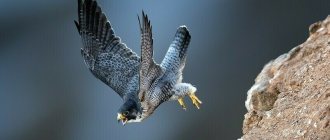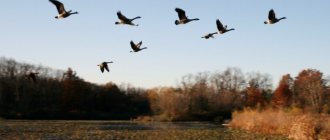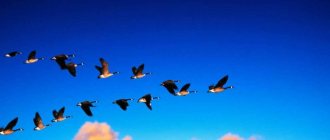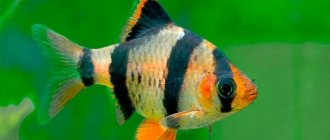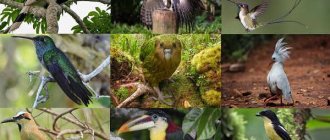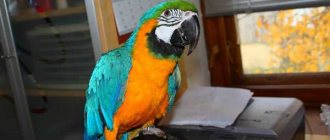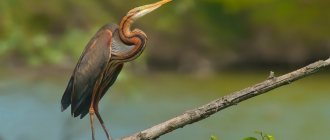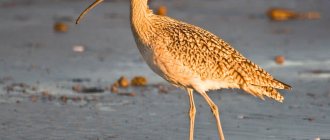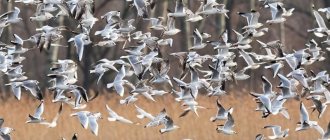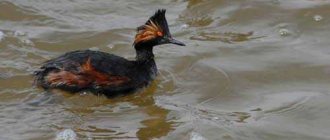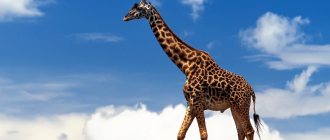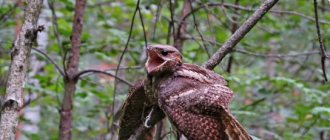The Moscow region is increasingly becoming a separate unique world, and not a place associated only with Moscow. This also applies to the animal world. The Moscow region is rich in species of birds and animals that you are unlikely to see in the everyday bustle of the metropolis. This phenomenon is largely explained by the climate and diversity of landscapes in the area. In this article you will get acquainted with the diversity of birds characteristic of this corner of Russia.
The territory of the Moscow region attracts the attention of ornithologists in the country. In fact, the list of birds living in this place can be compiled endlessly, let’s look at some of them:
- Golden eagle
- mute swan
- Coot
- White stork
- Oriole
- Moskovka
- Jay
- Merlin
- Burying ground
- Landrail
- White-tailed eagle
- Great snipe
- Finch
- Kingfisher
Let's take a closer look at the photos, Latin names and descriptions of these bird species living in the Moscow region.
Golden eagle (Aquila chrysaetos)
The bird of prey of the order Accipitridae amazes with its size. The wingspan of the golden eagle reaches 2.5 meters, which allows it to hunt hares, lambs and rodents. This is the largest eagle, meeting with which can be dangerous.
The golden eagle is characterized by a dark brown color with yellowish feathers on the neck and back of the head. He avoids human encounters and residential areas. Lives sedentary and mostly stays in pairs near the nest.
Unfortunately, the golden eagle is on the verge of extinction due to susceptibility to poaching, urbanization and other reasons. The bird has always been a rare species in the region, but encountering isolated individuals is still possible. The golden eagle is listed in the Red Books of individual regions, and is also protected in reserves of regional significance.
They nest irregularly in the Moscow region
Little grebe and grey-cheeked grebe
The little one, the only one in the order of grebes, does not have fluffy feathers on its head. In addition, as the name of the bird suggests, it is miniature. The gray-cheeked grebe is 2 times larger, reaches 45 centimeters in length, and spreads its wings to 75. The bird weighs approximately 0.5 kilograms. The animal has gray feathers on its cheeks, hence the name of the species.
The little grebe is considered the most cautious of the genus. The birds go down to the water only at night, so that predators and humans do not see. Representatives of the gray-cheeked species are less timid.
Pictured is a gray-cheeked grebe
Of all the toadstools, only the little one does not have a “cap” of feathers
Grey goose
This is the ancestor of domestic geese, domesticated in Mesopotamia. Domestication was simple. Chicks consider the first one they see after birth to be their parent. When people were nearby instead of birds, young geese followed them. Part of the population remained free.
The body length of the gray goose reaches 90 centimeters. The wingspan of the bird is 130 centimeters. The animal weighs 3-4 kilos. Geese provide humans not only with valuable meat, but also with feathers. They were once used to make writing instruments and feather beds. In modern times, goose feathers are used only for pillows.
Common goldeneye
It belongs to the duck family and stands out among them for its aggressiveness. Gogols attack anyone who encroaches on their territory, even humans. Birds are especially aggressive during the mating season. At this time, the animals make a characteristic sound: “beep-beep.”
Listen to the voice of the common goldeneye
Gogol is medium in size. The length of the bird is 35-40 centimeters. Among other ducks, the goldeneye stands out for its white and black color. The dark head and back are green.
Common scoter
This is also a wild duck. She is completely black. Only the mossy feathers along the edges of the wings are light and there is a white edging around the eyes. The scoter is distinguished by a bump at the base of the nose, which makes it humpbacked.
The scoter is the largest duck, reaching a length of 60 centimeters and weighing about 1.5 kilos. Females are slightly lighter and smaller.
Steppe Harrier
It belongs to the accipitridae and is protected as an endangered species. Its representatives are colored light gray. The wings are darkened, almost brown. You can see the bird in open areas. Hence the name – steppe.
The length of the harrier extends to a maximum of 46 centimeters. The wingspan of the bird is about 1 meter. What birds live in the Moscow region are detected by video surveillance cameras installed in the fields by ornithologists and zoologists.
Steppe Harrier
Pygmy eagle
Weighs no more than 900 grams, which makes it the smallest among eagles. Like the harrier, the dwarf is listed in the Red Book and is protected as a migratory bird.
Among eagles, dwarfs are the only ones that mate for life. If a mate dies, the survivor devotes one breeding season to mourning. The bird begins to try to create a new family after a year.
In the photo there is a dwarf eagle
Black-headed gull
Otherwise it is called the black-headed chickadee. The head of a bird, painted dark, looks like a nut. The rest of the plumage is white except for a few feathers at the end of the tail. The paws and beak of the animal are reddish. You can meet black-headed gulls on lakes, unlike most species in the genus that inhabit seashores.
The size of the black-headed gull is 35 centimeters in length, 1 meter in wingspan. The bird weighs approximately 200 grams.
Mute swan (Cygnus olor)
Belongs to the duck family, differs from other swans in its size - it is one of the largest among them. The wingspan of a mute swan reaches 220 centimeters, and its weight is up to 18 kilograms.
It has an elongated body, a very long neck, and an orange-red beak. The main diet consists of aquatic plants and small animals, such as mollusks.
The bird got its name due to the sound that the mute swan makes when irritated. By its nature, it is quite aggressive, always striving to fence off its territory from the invasion of other birds or humans, often with the help of sounds. That is why the typical habitats for the bird are swamps and reservoirs with abundant vegetation. However, the bird is often kept in the reservoirs of city parks.
Interestingly, mute swans are also revered in other countries. For example, in Denmark they are a national symbol, and in Great Britain these birds have a special status and are considered the property of the queen.
Found on migration in the Moscow region
Red-throated loon
It is the smallest among Russian loons. The bird is 53-69 centimeters in length and weighs 1-2 kilograms. The wingspan of red-throated individuals does not exceed 120 centimeters. Externally, the animal is distinguished by a scarlet color on the front of the neck and a grayish back without sharp streaks. Other loons have black backs with markings.
Loons inhabit lakes in the tundra. The heartbreaking screams of the red-throated creatures in it frighten many. Birds have a special voice. He is loud, loud, harsh.
Wigeon
This duck is also known for its characteristic whistle-like sounds. The animal does not make a typical “quack”. By the way, the wigeon is almost as big as the mallard duck, being the second largest in the genus.
Listen to the voice of the wigeon
The length of the whistling duck reaches 50 centimeters. The wingspan is 80 centimeters.
If there are swans on the pond, ducks stay close to them. Not liking diving for underwater herbs and rhizomes, wigeons pick up the remains of the meal of long-necked birds.
Golden Plover
Refers to waders. Like them, the plovers have a strong and short beak, legs that do not differ in length, a sort of chopped off tail. On top, like the rest of the body, it is dark with golden streaks. The bird's belly is black, and between it and the top there is a white stripe.
The plovers have 2 subspecies. One is a typical resident of the north. Birds of Moscow and the Moscow region belong to the southern subspecies. Its representatives are included in most regional Red Books. The number of this already rare species is steadily declining.
Garschnep
A desirable trophy for sport hunting. Hitting a small and fast bird is the height of skill. Garschnep is identical in size to snipe. Actually, the bird belongs to the snipe family. With a body length of 19 centimeters, the bird weighs approximately 50 grams.
It is known that until the 20th century, the garnish was constantly nesting in the Moscow region. Now even single individuals do not establish nests in the region, flying past their once favorite places.
Red-breasted Pipit
A miniature bird with a body length of up to 15 centimeters and a weight of up to 30 grams. The pipit owes its name to the reddish plumage on its throat and its brisk hopping when walking.
The red-breasted pipit nests in swamps. Here you can find 40 species of birds belonging to the wagtail family. However, in the Moscow region only red-breasted individuals are found.
Red-breasted Pipit
Coot (Fulica atra)
The coot belongs to the rail family. Most often it can be found in reservoirs. In winter, the Coot, like all migratory birds, leaves the Moscow region. She goes to Asia and Europe, to the sea coasts.
This bird got its name due to its well-recognized appearance - black color, white beak and bald forehead. The size of the coot is similar to an average duck. The wingspan is up to 70 centimeters, weight is 500-1000 grams.
The basis of the coot's diet is plant food, while animal food makes up no more than 10% of the bird's diet. At the same time, the coot obtains food both in water and on land.
goshawk
The goshawk is one of the largest feathered predators in the capital. It is almost twice as large as a crow - the size of an adult can reach 65 centimeters in length. Moreover, female goshawks are much larger than males. These predators do not differ in brightness of color. In adult birds, the upperparts are dark gray and the underparts are light. Light eyebrows are clearly visible above the eyes.
Hawks eat only animal food. In the wild, they hunt jays, ducks and grouse, and can catch squirrels and other rodents. Within the city, their usual food is pigeons, crows, blackbirds and other birds. Goshawks hunt from ambush and maneuver well in flight, as they often pursue prey hiding between trees. But these birds almost cannot soar like other hawk-like birds.
Goshawks make their nests in tall trees; pairs usually stay in the same nesting area for many years in a row and lead a sedentary lifestyle.
The goshawk is listed in the Red Book of Moscow, although it belongs to the fifth category of rarity. This means that currently the number and distribution of the species in the capital has increased to a safe level.
In Moscow, goshawks nest in almost all large forest parks - they have been seen in more than 30 territories inside the Moscow Ring Road.
White stork (Ciconia ciconia)
Living primarily in swampy areas, the white stork is distinguished by its white plumage and long, powerful beak. It can be found near human habitation - on the roofs of houses and poles. The mass of an adult individual reaches 5 kilograms, and the wingspan is 200 centimeters.
The main food of this bird consists of small vertebrates and many invertebrate animals - frogs, grass snakes, earthworms, chafers.
The white stork is one of a number of birds in the Moscow region that are on the verge of extinction. In the second half of the twentieth century, white storks nested in many areas of the Moscow region, but were attacked by humans. This has caused nesting events that are not always successful, and has also given rise to concern for the future of this species.
Reasons for declining bird populations
Deforestation, construction of new residential areas and general environmental deterioration inevitably affect the number of birds. Birds of the Moscow region are forced to either adapt to changing environmental conditions or leave their usual habitats, migrating away from humans and their destructive activities.
Every year in the Moscow region there is a decrease in the populations of many species, and the task of our society is to prevent further depletion of the avifauna of this region.
Oriole (Oriolus oriolus)
Photo: Imran Shah / www.flickr.com
This bird is easy to spot due to its bizarre color - the oriole has yellow-black plumage and an elongated body structure. However, this feature also attracts natural predators – the enemies of the oriole.
The oriole is a small bird: weight – 50-90 grams, wingspan – approximately 45 centimeters. Very active, she almost never sits in one place, and her flight speed reaches 70 km/h.
Most often, the oriole lives on the tops of trees, mostly deciduous, and prefers moderate temperatures. Found alone or in pairs. Mainly feeds on insects and berries.
The Russian name of this bird is supposedly the same root as the word “moisture”, and in ancient times it was considered a harbinger of rain.
Buzzard
The honey beetle is the rarest of the capital's feathered predators. The Red Book classifies it as category zero. This means that its nests have not been found in Moscow for a long time. However, the bird itself has recently been seen in large forest parks, so experts do not rule out that honey beetles may settle in the city in the future.
It’s easy to recognize him when you meet him. This bird is medium in size. The plumage is brown above, light below and speckled. The head is light gray, the eyes are bright yellow. The grayish tail has three black stripes, which are especially visible during flight.
The honey beetle prefers sparse forest areas bordering river floodplains, large clearings and meadows. It begins nesting quite late - at the end of May, beginning of June. The honey beetle is characterized by unusual mating flights, when the male hovers in one place and flaps his wings over his back. The pair builds a nest at a height of up to 12 meters, always weaving green tree branches into the walls.
The honey beetle got its name for a reason. The basis of its diet is the larvae and pupae of wild bees, bumblebees and wasps. To search for insect nests, birds carefully monitor their flight path from cover for a long time. The dense plumage on the head protects the wasp from attacks by stinging insects. The honey buzzard's diet includes other small invertebrates, as well as amphibians, rodents and birds.
Moskovka (Periparus ater)
A bird of the tit family, energetic and small, also known as the black tit. Differs from the great tit in its smaller size, pale plumage on the rest of the body and more dense build. Body length is about 11 centimeters, weight reaches a maximum of 12 grams. The distinctive sign of this bird species is a small white spot on the back of the head.
The Muscovy's main habitat is coniferous forest, but it can also be seen near feeders in gardens and parks, where the Muscovy is content with nuts and food scraps. Mainly feeds on seeds of coniferous trees and insects.
It is interesting that initially the spelling of this type of bird was different - “masked”, which was due to the appearance of the bird, namely the black crown, similar to a mask. That is why, contrary to the widespread stereotype, the Muscovite has nothing to do with Moscow.
Sparrowhawk
The sparrowhawk is a small predator, smaller than a crow. It hunts mainly tits and sparrows. It attacks from an ambush like a goshawk, but can also hover in the air for a long time, looking for prey in the open space. Therefore, he prefers to settle in forests, near forest edges and meadows.
In Moscow, sparrowhawks lead a sedentary lifestyle. Pairs stay on a permanent nesting site, using the same nests in the treetops for several years. The chicks are hatched quite late; fledglings appear only in early July. With the birth of their young, birds can behave quite aggressively, sometimes even attacking a person who comes too close to the nest.
This species in Moscow has the third category of rarity. Sparrowhawks were observed in the natural and historical parks “Izmailovo”, “Bitsevsky Forest”, “Kuzminki-Lublino”, the Kuskovo Forest Park, in Serebryany Bor and in other natural areas.
Jay (Garrulus glandarius)
The jay belongs to the corvid family. It is characterized by unusual bright plumage, a wide crest and a long tail. The body of the bird is reddish-brown, the wings and tail are black, and the feathers on the shoulders are bright blue with black stripes. The wingspan is 50-58 centimeters, the average weight is 130-150 grams.
The jay perfectly imitates the singing of other birds, the human voice and the sounds of objects. The bird feeds on acorns and berries, but will not refuse insects and small fish. The jay is a forest nomadic bird.
There is an opinion that the name of the bird comes from the verb “to shine,” which means it was given to the jay for its bright color.
Summer inhabitants of forests near Moscow
In spring and summer, the singing of birds does not stop in the forest. In the green zone of the Moscow region you can hear the trills of a nightingale, the tunes of a waxwing, and the crackling of a magpie.
Everything around is filled with chirping, chirping and melodious songs. From the beginning of March to mid-summer, birds living near Moscow have a mating season. Ornithologists joke that even a crow in the spring croaks more euphoniously.
Gyrfalcon (Falco rusticolus)
Bird of prey, the largest representative of the falcon family. The wingspan reaches 135 centimeters, the weight of the female is up to 2 kilograms, the male is a little more than 1 kilogram. It is distinguished by its special endurance. The color of the gyrfalcon is variable: from brownish-gray to almost white.
The gyrfalcon has a massive build and long, sharp wings. This helps the bird obtain food, which consists mainly of small mammals and smaller birds.
The voice of this bird is similar to the voice of a peregrine falcon, and in the spring it can even produce a rather high trill. The name most likely goes back to an onomatopoeic Proto-Slavic verb, indicating the sounds made by a bird.
Unfortunately, catching gyrfalcons is common in Russia, which is why administrative liability and fines are provided for poaching and selling this bird in the country.
Kremlin Falcons
It turns out that there is a place in Moscow where birds are not only not fed, but are also exterminated. This is the very heart of Russia – the Kremlin. Back in 1979, the security service began the fight against crows, which were crap on Muscovites and guests of the capital and spoiled flower beds. It’s not for nothing that they are called one of the smartest birds on the planet: for the sake of entertainment, they have learned to slide off the domes of nearby cathedrals, simultaneously tearing off gold leaf with their claws. This, of course, could not continue for long.
A falcon nursery appeared in the Kremlin, quickly solving the problem of the presence of crows and pigeons. During morning and evening flights, these natural hunters kill up to 15 birds. Peregrine falcons, falcons, goshawks, gyrfalcons - they are all in service and receive allowances in the form of white mice, which are ordered by the Ministry of Defense.
Many airports deal with unwanted birds in a similar manner, since a bird caught in a windshield or engine can cause a disaster, as was the case with wild geese on the Hudson.
Imperial Eagle (Aquila heliaca)
The Imperial Eagle is a large bird of prey of the order Accipitridae, a relative of the golden eagle, but the Imperial Eagle differs from it in its lighter plumage. The bird has long wide wings and a straight tail. The wingspan is 180-215 centimeters, and the weight reaches 4.5 kilograms.
The Imperial Eagle can be found in small areas of forest and large areas; it prefers flat landscapes. Younger individuals migrate south. The burial ground is protected by the Red Books of Russia.
This bird is considered vocal, its cry vaguely resembles the barking of a dog. It is most noisy at the beginning of the breeding season. Hunts medium-sized game - marmots, some small birds, gophers. There is plenty of prey from the surface of the earth, but in the case of birds, sometimes on takeoff.
Birds of the Moscow region
- golden eagles;
- kites;
- honey beetles;
- goshawks;
- oatmeal;
- bullfinches;
- crossbills;
- tap dancing;
- owls;
- siskins;
- blackbirds;
- seagulls;
- goldfinches;
- hazel grouse;
- kingfishers;
- orioles;
- white-tailed eagles;
- geese;
- crows;
- pigeons;
- nightingales;
- lapwings;
- waxwings;
- terns;
- jays;
- peregrine falcons;
- wood grouse;
- partridges;
- cuckoos;
- falcons;
- owls;
- woodpeckers;
- nightjars;
- Moscow;
- wagtails;
- corncrakes;
- starlings;
- robins;
- coots;
- jays;
- finches;
- storks;
- snipe;
- bluethroats;
- swans;
- tits;
- warblers, etc.
Corncrake (Crex crex)
It is distinguished by its small size and camouflage plumage. The corncrake has a dense build, an elongated neck and a rounded head of a reddish-ochre color. It is slightly larger in size than a blackbird. The weight is 80-200 grams, the wingspan is on average 50 centimeters.
The corncrake is a migratory bird; in winter it flies to Africa. It is noteworthy that during its life the bird prefers not to fly, but during migration it is able to cover long distances by air.
The corncrake is quite difficult to see, since it lives in tall grass and leads a secretive lifestyle. Even in case of danger, she would rather run away than fly away. The corncrake feeds on insects, greens and small insects. The bird nests near swamps and wet areas.
Previously, the corncrake was on the verge of extinction, but over time the situation improved and today it lives quietly in the Moscow region.
Winter birds of the Moscow region
The bird population of the green areas around the capital varies according to the seasons of the year. Winter birds in the Moscow region are represented by several species of woodpeckers, including red woodpeckers, tits, jays, and starlings. Among the dense vegetation you can see nuthatch, pika, waxwing, siskin, redpoll, and wren. Spruce crossbill and many other birds winter in coniferous forests, the main food for which is seeds.
Climate change has also affected birds. For several years now, scientists have been observing that many rooks have stopped flying to warmer climes and instead spend the winter in central Russia. Another new wintering bird in the Moscow region is ducks. These waterfowl remain in urban non-freezing reservoirs, where they are fed by local residents.
White-tailed eagle (Haliaeetus albicilla)
This is a fairly large bird of the hawk family. Its weight reaches 7 kilograms, and its body length is 90 centimeters. The eagle differs from other birds of prey by its large and powerful beak.
The bird has a brown color, a pure white tail and a yellow beak. Younger individuals have a brown tail. The white-tailed eagle primarily feeds on fish or water-related birds and mammals. Therefore, it lives near reservoirs rich in fish and leads a lifestyle hidden from humans.
The white-tailed eagle is listed in the Red Book of Russia and the International Red Book as a particularly vulnerable species. The white-tailed eagle is subject to poaching, tourism and nest destruction. To preserve it, it is necessary to expand the creation of reserves with nesting areas.
Birds of prey of Moscow and Moscow region
Among the representatives of owls, the gray owl is most widespread in the capital region. It can be found even in populated areas, especially in winter. The predator feeds on small rodents and small passerine birds.
There are also many long-eared owls in the vicinity of Moscow. She prefers mixed and coniferous forests, sometimes wintering in city parks. Its diet is identical to that of the tawny owl.
In addition to those listed, within the boundaries of the region you can observe the great owl, the great owl and the little owl. But the snowy owl, great gray owl and great owl are rare.
Gyrfalcons, peregrine falcons, white-tailed eagles, golden eagles, which in the past were found in sufficient numbers in the forests near Moscow, are now a great rarity.
Sparrowhawks, goshawks, kestrels, and winterbirds are common birds of prey in the Moscow region.
Great snipe (Gallinago media)
Photo: Thho46 / Wikimedia Commons
Bird of the snipe family. The plumage of the great snipe is brown with splashes on top, lighter below. There is a dark stripe from the base of the beak to the eye, and two white stripes are located on the wings. The wingspan varies from 42 to 46 centimeters, weight - from 150 to 260 grams.
It is considered one of the fastest migratory birds, and they practically make no stops on their way. The great snipe feeds mainly on insects, worms, and occasionally plants. Breeds in swamps and river valleys. Winters in southern Africa.
In the 19th and 20th centuries, the number of these birds decreased noticeably due to their attractiveness to hunters, peat mining, and plowing of wetlands. For a long time it was believed that because of this, the snipe is found in the Moscow region only in separate pairs. Nevertheless, great great leks can be found in the eastern regions of the region.
Pheasant family
The wood grouse is the largest forest bird of the grouse family, living in these surroundings. Likes to settle near swamps. Prefers a sedentary lifestyle, but can sometimes fly from one place to another. Endowed with beautiful plumage and bright colors. Moreover, males wear more colorful feathers than females. Their back is black and gray with light speckles, their chest is green with a vague metallic tint. In spring, birds' eyebrows swell and temporarily turn red. In winter, wood grouse live in flocks and preferably in coniferous or mixed forests, dominated by coniferous trees.
The capercaillie is the largest forest bird of the grouse family.
The gray partridge is often found throughout Russia. Many people, especially hunters, know what a bird from the pheasant family looks like. The length of its body is about 30 cm, its weight is from 300 to 450 grams, its wingspan is up to 48 cm. An individual with an ocher face, a small head and a well-developed back and chest.
Finch (Fringilla coelebs)
A small songbird of the finch family that is not afraid to settle near people. Mainly nests in trees and loves various forest landscapes. Finches can also be found in gardens, countryside and city parks. In winter they fly to warmer climes. Finches eat plants, seeds and insects.
Females are brownish in color, while males are brighter. Both individuals are quite noticeable in nature. The chicks have a light spot on the back of their heads. The wingspan is 24-29 centimeters, body weight is 16-30 grams.
It is noteworthy that the finch can compete with the nightingale for the title of best singer. This bird probably got its name from an onomatopoeic name, similar to the signals it makes.
Royal hunt
DDT vs Falcon
Today, the name of this bird is so far gone from our everyday life that when you say “peregrine falcon,” your interlocutor is sure that we are talking about a fast train.
Meanwhile, during the time of princely Moscow, coins were even minted with the image of a horseman with a peregrine falcon on his hand, and the Russian falcon itself was one of the symbols of the capital. The falcon yard in Rus' was started by Prince Oleg, who began breeding birds for hunting. Under Alexei Mikhailovich, this hobby reached its peak, and becoming a falconer in those years was a way to make a career.
In the 19th century, birds nested in the Khoroshevsky and Tsaritsyn forests, in Sokolniki, on Losiny Island; the memory of the falcons’ habitats was preserved in the names: Sokolinaya Gora, Sokolniki, Sokolnicheskaya Street. The towers, bell towers and towers of the Kremlin were the favorite nesting places for falcons - the main thing for them, anchorites, was that it was high, spacious, well-fed and safe. In the middle of the 20th century, peregrine falcons, one of the few predators that feel good in megacities, began to develop new high-rise buildings. But their happiness did not last long.
Since the 1950s, agriculture began to use the harsh pesticide DDT to protect against pests, considering it a panacea for all insects and not knowing that it accumulates in the body and is not excreted. They used it to poison insects, which were eaten by various birds, which became prey for the peregrine falcon. The poison accumulated in the birds' bodies, the shells of the eggs became fragile, and the chicks died. On the European territory of Russia, Russian falcons disappeared as a class (the last nest was seen on Losinka in 1968).
And they appeared only in 1995 - with the formation of the Russian Falcon Center at the All-Russian Research Institute of Nature, in the former Trubetskoy estate Znamenskoye-Sadki, in Northern Butovo. German ornithologists handed over several pairs of Russian falcons to their Moscow colleagues, and over the course of almost 20 years, they flew about fifty peregrine falcons in Moscow.
University Rocks
“Releasing a bird is not just opening a cage and, they say, fly, falcons, fly,” says Alexander Sorokin, head of the Falcon Center, head of the biodiversity department of the All-Russian Research Institute for Nature Conservation. “They are first brought up in a special way. A growing chick, for example, should not see a person, otherwise it will mistake us for parents and will not be able to reproduce normally.
White and pink balls of fluff, called peregrine falcon chicks, although they look at the junior researcher Irina Mogilnikova feeding them from tweezers, but, having hatched from the egg only a couple of days ago, they really don’t see anything. They begin to look at the world when they find themselves with a feeding falcon (as females who do not have chicks are called here), which, feeding them “from the hands” of a person, becomes the cubs’ natural mother.
The chicks grow, and they begin to be prepared for independent life: they are placed in a hackbox, a box where they receive food, also without seeing the person who feeds them, and at the same time they look closely at the sky through a lattice wall. From here the peregrine must fly free, and finding a place for the box is the most important thing. And when the time came for the first graduation, the scientists of the Russian Falcon Center immediately remembered the high-rise building of Moscow State University.
“These are practically the same rocks, with all their niches, cornices, ventilation windows, wind currents on which you can soar,” continues Sorokin. “We placed the box on the roof of the “professor’s tower” on the 11th floor, a few weeks later we raised the bars and the arena of life opened up in front of a pair of peregrine falcons.
The university “rocks” have become home to dozens of peregrine falcons, both scattered around the area and continuing to live here. But over time, the time has come to return the Russian falcon to its historical homeland - the Kremlin.
On guard of the Kremlin
First, a decoy crow was released from its hiding place, followed immediately by a hawk raised at the Falcon Center. He overtook her, and a cloud of alarmed crows rose above the Kremlin: according to the commandants, even gunfire did not frighten the black robbers.
In the 1980s, crows that overran Moscow became a disaster for the Kremlin: they tore off golden domes and pulled specially purchased Dutch tulips out of the ground. Desperate to deal with them, the commandant’s office employees invited specialists from the All-Russian Scientific Research Institute of Nature with their hunting birds, and since then the Kremlin has had its own ornithological service, trained to work with birds that live in special houses in the Tainitsky Garden. And on the Konstantino-Eleninskaya Tower there is a box, which today is the main place for releasing the peregrine falcon in Moscow.
But Russian falcons, although the main ones, are not the only inhabitants of the nursery of the Russian Falcon Center. The Kremlin ornithological service has recently been replenished with white gyrfalcons, confiscated at customs and transferred to the All-Russian Research Institute of Nature as the main specialists in caring for rare birds. In the nursery itself there live about a hundred birds that are not the most common among us: when you walk through it, in the open enclosures you see golden eagles, vulture-like Steller's sea eagles, owls, hawks, there is even the rarest fish owl, a huge white-gray beauty, capable dive for prey into icy water.
Meanwhile, just recently these enclosures were crumbling before our eyes; in spring and autumn it was possible to walk here only on boards thrown into impassable mud, no money was allocated to feed the birds, and they were fed with meat obtained thanks to the personal connections of the research staff. But a new director came to the research institute, and Sorokin and I walked along the tiled paths past the overhauled enclosures while talking about the purchase of the latest incubators. Excursions will begin here soon, and employees are ready to explain to schoolchildren with a hawk in their arms that, say, a long tail and short wings give maneuverability to a bird living in the forest.
And the peregrine falcon today lives and works in Moscow. Flying out of the walls of an ancient noble estate with a huge 18th-century oak tree growing in front of the manor house, he, for example, took on the usual work of an orderly, hunting sick birds that carried a dangerous infection. Using the remains of birds found in the peregrine falcon's habitats, scientists make samples of birds living in Moscow, and, as it turns out, lapwings, snipes, woodcocks, moorhens and even Arctic buntings live in the capital!
But the most important thing is that he, the peregrine falcon, in principle, settles in Moscow because this bird is unusually sensitive to the environment, to the cleanliness of the air. A Russian falcon lives in the city, which means that here, no matter what they say, you can breathe well.
By the way
The peregrine falcon is the fastest bird in the world. When, having gained altitude, it rushes at prey, it reaches speeds of up to 290 km/h. This is how the famous zoologist E.P. described the peregrine falcon’s hunt. Spangenberg: “Ahead of me, some obscure body cut through the air in an oblique line. Its speed was so rapid that it was difficult for me to grasp the outlines of what was rushing in the air. But the very next moment it became clear that the falcon had “hit” some large bird with its paws in flight, and it tumbled helplessly in the air, knocked out feathers flying to the side. Having caught up with its prey, the peregrine falcon grabbed it with its claws and, stretching out its legs and barely coping with the heavy burden, sank to the ground.”
